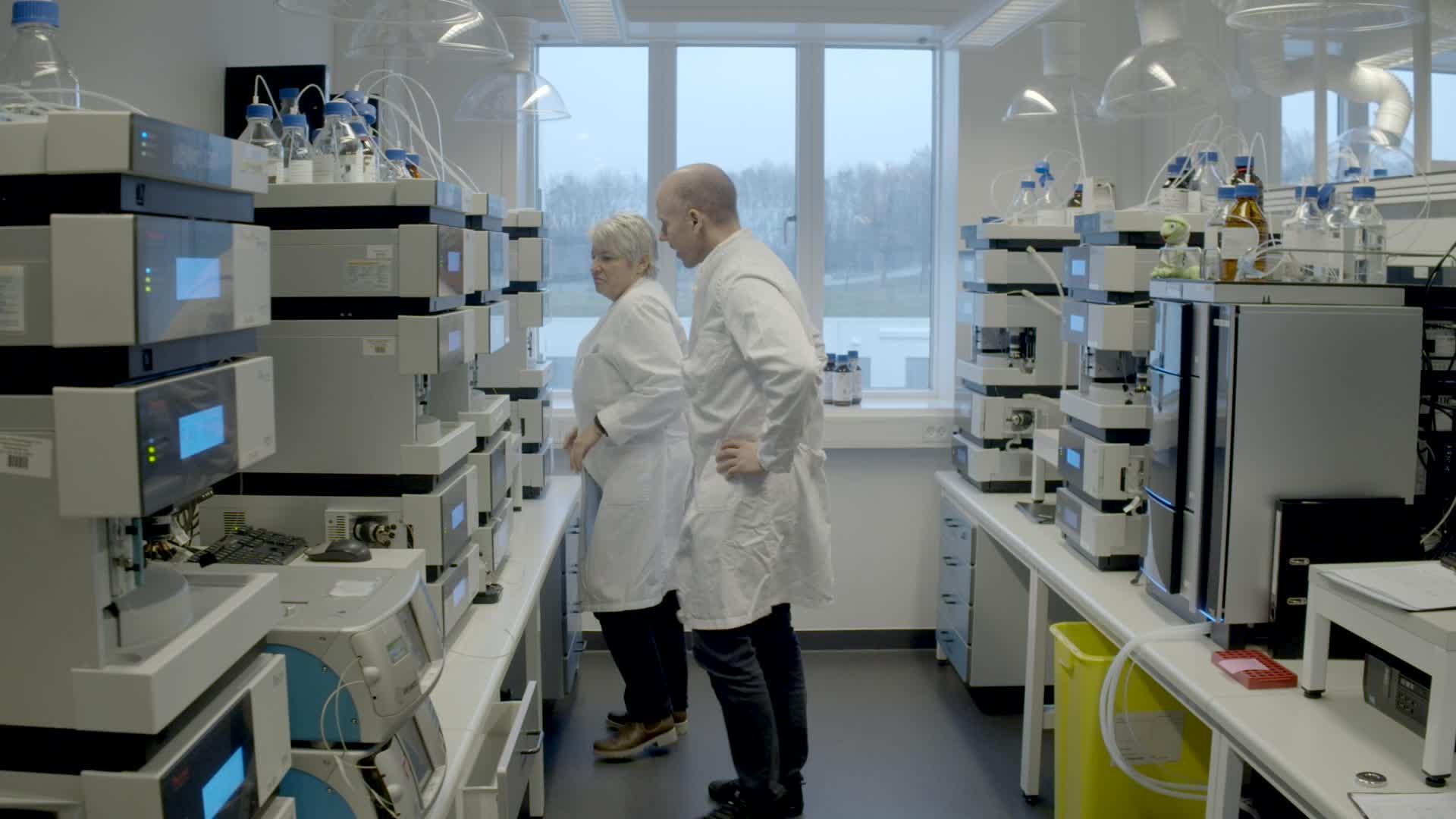
What are protein therapeutics?
Protein therapeutics are a specific class of biotherapeutics and in their simplest form include genetically engineered versions of naturally occurring human proteins. Protein therapeutics have several advantages over small-molecule drugs, providing the means to target highly specific, complex, and dynamic functions. Due to their specificity, protein-based therapies have less potential to cause adverse effects, are often well tolerated and are less likely to elicit immune responses.
Protein therapeutics such as monoclonal antibodies, biosimilars, bi-specifics, antibody-drug conjugates, and fusions proteins are made via recombinant DNA technology. Here recombinant proteins are produced in host cells, in which recombinant DNA, encoding the protein therapy, has previously been inserted thus instructing the host cells ribosomal machinery to express the desired recombinant protein-based therapeutic.
In comparison to chemical drug production, the protein-based therapeutic production process is complex, variable, and subject to elevated risk of product degradation and contamination. Process losses can be high, and the final product is fragile and can be negatively impacted by several factors including temperature, prolonged storage, denaturants, organic solvents, oxygen and changes in pH.
As a result, protein biologics require strict controls in manufacturing, transport and storage. An array of analytical approaches and workflows facilitate comprehensive characterization, allowing for full product understanding which can save significant time and development costs. Throughout process development and manufacturing, these analytical tools are required for reliable monitoring of product microheterogeneity ensuring drug safety and efficacy.
Intact mass analysis
Intact mass analysis is the assessment of the molecular weight of an intact protein sample using mass spectrometry (MS). Upon data processing, intact mass analysis allows for the determination of the average molecular mass or the monoisotopic mass of the protein of interest, depending on the resolving power of MS and the size of the protein. Typically, for large proteins such as monoclonal antibodies (mAbs), the average mass is obtained.
The observed mass can be compared to the expected theoretical mass for a given amino acid sequence to confirm protein identity, structural integrity, and presence and relative abundance of isoforms (e.g., glycoforms). Intact mass analysis provides information on antibody drug conjugates (ADCs), drug to antibody ratios (DAR), mAb sequence variations, impurities, and degradation products.
Native intact analysis
Unlike in standard intact mass analysis, during native intact analysis, also known as native mass spectrometry (MS), protein analytes are sprayed from a non-denaturing solvent in a process called electrospray ionization. The term ‘native’ describes the biological status of the analytes in solution prior to the ionization event. It is imperative that conditions such as pH and ion source parameters are controlled to maintain the native folded state of the biologic protein.
Protein analysis in native or native-like conditions decreases charge state values, resulting in detection at higher m/z ranges with more spatial resolution. Native mass spectrometry conditions also allow the preservation of structurally critical non-covalent bonds, providing the mass of biomolecules that associate noncovalently. Furthermore, limited sample preparation is needed in exchange for a high level of information.
See more resources
Subunit analysis
Enzymatic digestion and reduction of monoclonal antibodies facilitates analysis at the subunit level. A commonly used approach utilizes the cysteine protease produced by S.pyogenes, known as IdeS, which is highly specific. IdeS digestion followed by reduction generates three subunits that are readily separated by reversed phase (RP) UHPLC.
Subunit analysis involves faster sample preparation, and simplified data interpretation compared to peptide mapping or bottom-up characterization approaches and provides simultaneous characterization of multiple attributes of antibodies at domain levels.
See more resources
Peptide mapping analysis
Peptide mapping provides a comprehensive and accurate representation of the landscape of a particular protein. With peptide mapping you create full sequence information, displaying each amino acid constituent and where they are in relation to each other. Peptide mapping should provide information on all possible post-translational modifications and sequence variants, illustrating the many possible instances in which a single protein molecule can be modified. The technique should be reproducible and reliable.
Peptide mapping involves the digestion of a therapeutic protein into its constituent peptides via a chemical or enzymatic reaction. Separation and subsequent identification of these peptides provides the details necessary to elucidate a protein’s full sequence information. Structural characterization at this level provides information on post translational modifications (PTMs) such as site-specific glycosylation, amino acid substitutions (sequence variants) and/or truncations.
Advances in protein sample preparation chemistries, ultra-high performance liquid chromatography (UHPLC), mass spectrometry (MS) hardware, and intuitive software facilitate the generation of comprehensive, confident peptide maps.
See more resources
Charge variant analysis
Charge variant analysis is used to elicit the heterogeneity of charge variant forms or protein-based biologics.
Biotherapeutic proteins such as monoclonal antibodies (mAbs) are far more heterogeneous than small-molecule drugs. The presence of the charged state can significantly impact the structure, stability, binding affinity, and efficacy of the biotherapeutic drug. It is therefore necessary to understand the profile of the drug so that charge variants are identified and removed if necessary.
Charge variants of mAbs are due to modifications such as sialylation, deamidation, and C-terminal lysine truncation. Salt gradient cation-exchange chromatography has commonly been used with some success in characterizing mAb charge variants. However, significant effort is often required to tailor the salt gradient method for each individual mAb. In the fast-paced drug development environment, a quick and robust platform method is desirable to accommodate the majority of the mAb analyses.
See more resources
Multi-Attribute Method (MAM)
What is the Multi-Attribute Method?
The Multi-Attribute Method (MAM) is a peptide mapping-based method which takes advantage of high-resolution mass spectrometric data. High-resolution mass spectrometry provides the accurate mass information aiding identification of product quality attributes and consequent quantitation and monitoring, which leads to a more comprehensive biomolecule process understanding, allowing for better process control for manufacturing.
Modern biopharmaceutical drugs, such as monoclonal antibodies (mAbs) and antibody drug conjugates (ADCs), are tremendously complex molecules manufactured inside living cells. Characterizing and monitoring these compounds in chemistry, manufacturing, and controls (CMC), and quality control environments can present a significant challenge, but the use of high-resolution accurate mass (HRAM) mass spectrometry offers a powerful way of overcoming these challenges.
The additional dimension of separation combined with the sensitivity and specificity of Orbitrap MS yields deeper product knowledge than a combined battery of conventional characterization tests, eliminating many traditional lot release tests.
By directly measuring critical quality attributes at the individual residue level, understanding how changes in process or production affect a drug product becomes part of a "quality by design" approach. Together, the results provided by HRAM MS enable safer and more potent drugs to be manufactured, delivering an incredibly powerful research-to-routine workflow.
See more resources
Aggregate analysis
Therapeutic protein aggregation is the process in which protein molecules assemble into stable complexes composed of two or more proteins. The manufacturing and purification processes used to make protein therapeutics typically yield high purity, single protein molecules called monomers. Following production, therapeutic protein monomers can form aggregates during storage and/or transportation. Protein aggregation in biotherapeutics can lead to incorrect drug dosage and/or undesired, potentially fatal immune responses in patients. Consequently, careful monitoring of protein aggregates is important for safety and quality assurance.
Investigators routinely use size-exclusion chromatography (SEC), which separates particles according to hydrodynamic size, in order to determine aggregation levels in therapeutic protein samples. Recently, the use of hydrophobic interaction chromatography (HIC) as an orthogonal technique to SEC has also been a topic of great interest. HIC separates proteins based on hydrophobicity in their native state and can often detect changes in protein structure as well as aggregation.
Host cell protein (HCP) analysis
Recombinant biotherapeutics are generally produced using non-human host cells, with Chinese hamster ovary (CHO), murine myeloma, and Escherichia coli cell-lines most commonly used. During cell growth and harvest, endogenous proteins from these host cells are released and can detrimentally affect final drug product safety and efficacy.
Purification of drug products from host cell protein contaminants can be challenging, with low-level contamination remaining after purification. The detection and quantification of residual HCPs as potential process-related impurities is critical for biopharmaceutical companies in accordance with regulatory agency guidelines (ICH Q6B).
See more resources
Glycan analysis
Glycan analysis involves several approaches to investigate the sequence, structure, and location of carbohydrate molecules modifications on proteins or protein residues in biotherapeutics.
Glycans serve a variety of structural and functional roles in membrane and secreted proteins, with most proteins undergoing some degree of glycosylation during their synthesis.
Changes in the glycosylation pattern of protein biotherapeutics have been shown to impact their half-life, stability, safety, and efficacy. In general, glycans are divided into two main groups: O-linked and N-linked glycans. O-linked glycosylation involves the attachment of oligosaccharides to serine or threonine amino acid residues through an oxygen atom, and N-linked glycosylation involves the attachment of oligosaccharides to asparagine amino acid residues through a nitrogen atom.
More than 60% of therapeutic proteins are post translationally modified following biosynthesis by the addition of N- or O-linked glycans. Glycosylation of biotherapeutics can be influenced by a multitude of process related factors, such as pH, carbon source, dissolved oxygen, temperature during manufacture, and by the choice of expression system.
While glycosylation is the most common post-translational modification of proteins, it is also the most demanding from an analytical point of view. Biotherapeutic glycoproteins with complex glycosylation patterns have the potential to easily fall out of specification with changes in biomanufacturing processes. To meet regulatory demands such as ICH Q5E and ICH Q6B, manufacturers must carefully characterize glycosylation of proteins and its relation to the clinical activity of the therapeutic. The complete analysis of a glycoprotein provides information on the primary structure of the oligosaccharides as well as their variation at individual glycosylation sites.
See more resources
Higher order structure analysis
Hydrogen deuterium exchange (HDX) mass spectrometry (MS) is a powerful tool for studying the dynamics of higher order structure of protein-based therapeutics. The rate of hydrogen-to-deuterium exchange within the amide hydrogen on the backbone of biotherapeutics provides solvent accessibility information, and thus protein structure and conformation can be inferred.
Full structural characterization is critical in biopharmaceutical development where the subtle but critical local conformational changes can impact safety and efficacy.
For Research Use Only. Not for use in diagnostic procedures.

